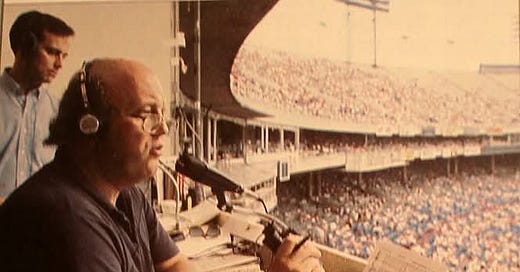Bird Tapes 2025: An Interview with Jon Miller (Part 1)
In our recent interview, the legendary broadcaster spoke at length, and with keen insight, on Earl, Eddie, Cal, EBW, 0-21, Jeffrey Maier, the importance of Camden Yards and, yes, his departure.
Baseball on the radio was still a very big deal in Baltimore when Jon Miller was the Orioles’ play-by-play broadcaster from 1983 through 1996.
The city’s sports landscape had something to do it. The Colts were gone. The Ravens didn’t exist (until 1996). The Orioles were the only team in town and prized like never before, consistently drawing far more fans to Memorial Stadium and Camden Yards (starting in 1992) than they ever drew during their on-field peak in the ‘60s and ‘70s.
The prevailing media landscape also had something to do with the prominence of the radio broadcasts in those years. Television coverage hadn’t reached the saturation point (now the norm) at which a fan could sit at home and watch every game. And the internet and social media hadn’t come along to fundamentally alter how many fans consume baseball.
Bottom line, the Orioles’ radio broadcasts mattered. And with Miller on the call, they were a must-listen.
He was a Bay Area native who’d come to Baltimore after working in Texas and Boston, and once Oriole fans heard him, they wondered how anyone had let him leave. His towering powers of observation and description, stentorian voice and dashes of humor turned baseball play-by-play into high art.
Even if the Orioles were getting blown out, you didn’t turn off the radio because Miller was so entertaining and enlightening.
He was Baltimore’s village storyteller, his work as integral to the local baseball experience as what happened on the field.
Miller’s departure after the 1996 season was among the Orioles’ biggest subtractions ever. Fans never forgave owner Peter Angelos for letting it happen.
When I interviewed Angelos in 2000 for my book on Orioles history, he gave his version of what happened, holding Miller accountable and bitterly blaming the media for the fact that he was blamed. (My interview with Angelos is in the Bird Tapes archive, available to paid subscribers.) Miller, who became the San Francisco Giants’ play-by-play broadcaster when he left Baltimore and still holds that job 29 years later, dove deeper into the subject than I’ve ever heard while giving his contradictory version of what happened in my recent interview with him.
I’m excited to add my conversation with Miller to the Bird Tapes archive, starting with Part 1 today. (I’ll post Part 2 and Part 3 in the coming weeks, and as noted, it’s all available with a paid subscription. If you want to upgrade from free to paid, click on the “subscribe now” button.)
Miller’s controversial departure was just one of the many topics he covered in his interview. I sought him out for his thoughts on everything he saw in his Baltimore years, a tumultuous epoch that included the Orioles’ highest highs (1983) and lowest lows (1988). He expounded at length on all of it, offering detail and insight on Earl Weaver, Eddie Murray, Cal Ripken Jr., Edward Bennett Williams, the 0-21 start, Fantastic Fans Night, the Jeffrey Maier game (sorry to bring it up), how moving to Camden Yards changed the Orioles and many other subjects.
I’m biased, but Miller has few peers, if any, as an Oriole historian, and our interview constitutes a riveting and far-reaching history lesson unavailable anywhere else.
Back in the day, fans joked that Miller was so good he could open the phone book to any page, start reading and make it sound like Shakespeare. (Remember the phone book?) His career reached a pinnacle in 2010, when was enshrined in the Hall of Fame as the winner of the Ford C. Frick Award, which honors broadcasting excellence.
Baltimore fans knew their village storyteller had a ceiling that high long before he reached it.
He is still calling the Giants’ games at age 73, and during our recent conversation, as he excitedly recounted stories about the Orioles, I couldn't help noticing what really is the most important reason why his broadcasts were so important years ago and still are: A lot of people love baseball, but no one loves it more.
Keep reading with a 7-day free trial
Subscribe to The Bird Tapes to keep reading this post and get 7 days of free access to the full post archives.





